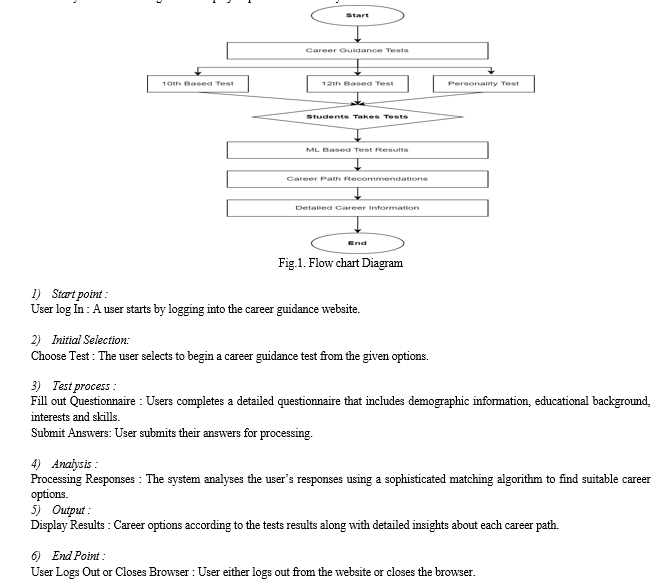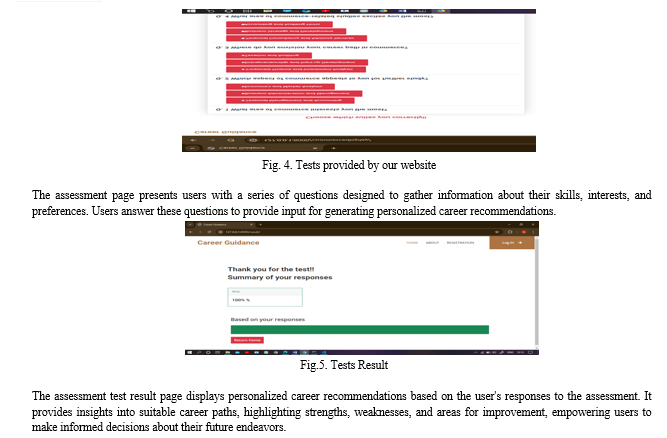Ijraset Journal For Research in Applied Science and Engineering Technology
- Home / Ijraset
- On This Page
- Abstract
- Introduction
- Conclusion
- References
- Copyright
Prolific Career Path: ML-based Career Guidance
Authors: Minal V. Patil, Dr. Anuja A. Khodaskar, Bhagyashree G. Mohane, Snehal W. Wasankar, Trushali A. Lekurwale, Pratiksha R. Naik, Anmol S. Monde
DOI Link: https://doi.org/10.22214/ijraset.2024.60699
Certificate: View Certificate
Abstract
The system titled “Prolific Career Path: ML-based Career Guidance” presents a detailed career path for the students who confused about their career. Most of the students across the globe are always in confusion after they complete higher secondary and therefore, the stage where they need to settle on an appropriate career path. The students don\'t have adequate maturity to accurately understand what a private has to follow to decide on a congenial career path. The system aims to Introducing the Career Guidance System enables students to choose the career path best suited to their personality, interests, and skills without much efforts The system providing MCQ based tests for secondary students as well as for higher secondary students according to their previous field. So in our system we have used an logistic regression for predicting the best career field for students according to their interests.
Introduction
I. INTRODUCTION
In an era where career landscapes are continuously evolving, driven by technological advancements and changing economic demands, the need for effective career guidance has never been more pronounced. Traditional career counseling methods, while beneficial, often fall short of addressing the complex, personalized needs of individuals navigating through their professional journeys. The advent of Machine Learning (ML) in career guidance heralds a transformative shift, offering scalable, data-driven solutions that promise a more personalized, insightful, and proactive approach to career planning and decision-making. Additionally, this research paper aims to explore the application of logistic regression in developing a career guidance system that not only recommends careers to individuals based on their skills, interests, and educational backgrounds but also predicts the likelihood of their success in various professions. Unlike more complex models, logistic regression provides clear insights into the relationship between input variables (e.g., skills, interests) and outcomes (e.g., career paths), making it an invaluable tool for individuals alike to understand and navigate the career decision-making process.
II. LITERATURE REVIEW
A. Introduction
Choosing a career path is a pivotal decision for secondary school students. Traditional methods often rely on standardized tests and limited counselor availability. This paper explores the growing potential of Artificial Intelligence (AI) to revolutionize career guidance in secondary education.
B. Current State of AI in Career Guidance
Sampson et al. (2020) highlight the growing interest in AI for career guidance. They discuss how AI can personalize information delivery, support assessments, and offer interactive exploration tools. Their research suggests AI can be a valuable asset in career guidance [1].
However, a critical perspective is offered in "Scrutinising Artificial Intelligence-based Career Guidance and Counselling Systems: an Appraisal" (2018). This paper acknowledges the potential benefits of AI but emphasizes the importance of human expertise alongside AI tools for effective career counseling. The authors advocate for a balanced approach that leverages the strengths of both AI and human counselors [2].
C. Benefits of AI-powered Career Guidance
Personalized Learning: AI can analyze student data (interests, skills, academic performance) to recommend personalized career paths that align with their unique profiles [1].
Accessibility and Scalability: AI-powered tools can provide 24/7 guidance, expanding access beyond traditional counselor availability and geographical limitations. This allows for greater scalability to support a larger student population [1].
Data-Driven Insights: AI can analyze vast amounts of career data, including job market trends, salary information, and skill requirements. This allows students to make informed decisions based on up-to-date information and emerging trends within various fields.
???????D. Examples of Real-World Implementations
SIH 2023 Team's "Bright Vision PS" project demonstrates a student-developed website with AI features for career counseling. This project showcases a student-led initiative exploring the possibilities of AI in this domain [3].
vaishnavipatil29/Career-Guidance-ML-Project on GitHub is a concrete example of an AI-powered career guidance project using machine learning techniques. This open-source project provides valuable insights into the technical aspects of developing such systems [4].
???????E. Challenges and Considerations
Algorithm Bias: AI algorithms can perpetuate biases present in the data they are trained on. Addressing fairness and explainability is crucial to ensure AI recommendations are accurate and unbiased.
Human Interaction: While AI offers valuable tools, human counselors remain essential for providing emotional support, navigating complex career decisions, and offering personalized guidance that goes beyond data analysis [2].
Data Privacy: Protecting student data privacy must be a top priority when developing and implementing AI-powered guidance systems. Clear ethical guidelines and robust security measures are necessary.
F. Future Directions
Research in AI-powered career guidance is ongoing, with promising advancements on the horizon:
Integration with Educational Platforms: Seamless integration of AI-powered career guidance tools with existing educational platforms could allow students to explore career options throughout their schooling.
This would provide a more holistic approach to career exploration.
Advanced AI Chatbots: The development of advanced AI chatbots offering personalized counseling and guidance could further enhance the accessibility and interactivity of AI-powered career guidance systems.
Virtual Reality Experiences: Incorporating virtual reality experiences into AI-powered career guidance could allow students to explore different career environments in a more immersive way, providing a richer understanding of potential career paths.
???????G. Conclusion
AI presents a promising avenue for enhancing career guidance in secondary education. By leveraging personalization, accessibility, and data-driven insights, AI tools can empower students to explore diverse career options and make informed decisions about their futures. However, it's crucial to address challenges like bias and ensure human expertise remains integrated within the guidance process. As research progresses and real-world implementations continue, AI-powered career guidance has the potential to revolutionize how students navigate their futures.
III. METHODOLOGY
A. Problem Statement
In the contemporary landscape of career decision-making, individuals are faced with a myriad of options across various industries and job roles, often leading to confusion and indecision. Traditional career guidance approaches, while valuable, may lack personalized insights and real-time adaptability to individual preferences and market trends. This underscores the need for innovative solutions that leverage machine learning (ML) techniques to enhance the effectiveness and relevance of career guidance platforms.
???????B. Problem Analysis
This research aims to address the aforementioned limitations by developing a novel career guidance website empowered by machine learning algorithms.
The proposed solution will utilize ML techniques to analyze large datasets of career pathways, job market trends, and individual user profiles to deliver personalized recommendations and actionable insights tailored to each user's specific needs and preferences.
IV. ANALYSIS OF PROBLEM STATEMENT
A. Identification of Existing Gap:
The problem statement effectively identifies a gap in current career guidance solutions, emphasizing their lack of personalization and real-time adaptability to individual preferences and market trends.This analysis sets the stage for the proposed research by highlighting the need for innovative solutions to enhance the effectiveness of career guidance platforms.
???????B. Proposal of Innovative Solution
The problem statement proposes the development of a novel career guidance website empowered by machine learning algorithms.By leveraging machine learning techniques, the proposed solution aims to address the identified gap by providing personalized recommendations and actionable insights tailored to each user's specific needs and preferences.
C. Clear Objectives
The problem statement outlines clear objectives for the proposed research, including achieving personalization, real-time adaptability, and predictive analytics within the ML-powered platform.The problem statement articulates the significance of the research study in advancing career guidance practices through the integration of machine learning techniques and user-centric design principles.By emphasizing the potential benefits of the proposed solution, the problem statement underscores the importance of addressing the identified gap in current career guidance solutions.
???????D. Conclusion
Overall, the problem statement effectively identifies a gap in existing career guidance solutions, proposes an innovative solution leveraging machine learning techniques, outlines clear objectives for the research study, formulates specific research questions, and highlights the significance of the study. This comprehensive analysis lays the groundwork for the research paper, providing a clear rationale for investigating the proposed solution and its potential impact on improving career guidance practices.
V. PROPOSED WORK
Due to misguidance or peer pressure, students often end up choosing an academic major that is incompatible with their interests and passions. To avoid this dilemma, we have proposed this website wherein, students will have a platform to find the right information about their fields of interest and test their skills in different streams to see where exactly they excel and give them proper career guidance to achieve the heights of success. The proposed work aims to revolutionize career guidance for secondary school students by leveraging Machine Learning (ML) and innovative digital platforms. The project will begin by conducting tests and providing valuable information about different career choices. Subsequently, offering a range of interactive features such as personality tests, and detailed career pathways. Furthermore, the system provides ML-based career recommendations. The overarching goal of this project is to democratize access to high-quality career guidance, empowering every student to make informed decisions about their future pathways and maximize their potential for success in the workforce.
VI. SYSTEM DESIGN
A. Planning
Study existing career guidance platforms to identify successful features and functionalities. Look for gaps in the market that our websites can fill. An abstract is done based on information gathered and the system that has been agreed to be developed.
???????B. Requirement Analysis:
Classify requirements as must-have, should-have or nice-to-have based on their importance and feasibility.
???????C. Design:
Test the design on various devices to ensure a consistent user experience across platforms. In this phase, several diagrams like context diagram, data flow diagram etc. and designs are given to know more details about the entire system.
These can also be a guide for the development of the system. Develop usr personas representing different types of users(e.g. high school students, college students, college students, carrer changers).
???????D. Implementation and Testing:
This phase is where the design is implemented into the coding. After writing the code, the module is tested by unit testing to test the single module of the system. After that, system testing is conducted to the test for the error of the whole system. Any errors or bugs will be fixed and the system will repeat the testing phase until there are none of errors or bugs are found. Then, after testing is finished, the first version of the system is released.
???????E. Deployment
After the system is bug-free, the system can be released and the user can access it. Once the system is in steady state, it is reviewed that the system met all the goals in the project plan for satisfactory results.


 ???????
???????
Conclusion
In conclusion, our research paper underscores the critical significance of providing tailored career guidance resources for students navigating the pivotal junctures of their educational journey. Through the development of our comprehensive website, we have endeavored to address the diverse needs of 10th and 12th-grade students by offering a structured framework for discerning their academic aptitudes and career aspirations. By integrating detailed assessments and personality tests, our platform empowers students to make informed decisions about their future endeavors based on their strengths and inclinations. Moreover, the inclusion of specialized information for Engineering and Medical fields further enhances the utility of our resource, offering students invaluable insights into potential career pathways within these disciplines. Through ongoing refinement and adaptation, we endeavor to ensure that our career guidance platform continues to serve as a beacon of guidance and inspiration for students embarking on their journey toward fulfilling and meaningful careers.
References
[1] Sampson, James P., et al. \"The Role of Artificial Intelligence in Career Guidance.\" Career Development Quarterly, American Counseling Association, 2020. [2] Tehseen Mehraj , Asifa Baba. \"Scrutinising Artificial Intelligence based Career Guidance and Counselling Systems: an Appraisal.\" International Journal of Interdisciplinary Research and Innovations ISSN 2348-1226 (online) Vol. 7, Issue 1, pp: (402-411), Month: January - March 2019. Available at: www.researchpublish.com [3] Bright Vision . team leader : Barath Kumar M P . \"Bright Vision PS: Making career choices and AI based counselling accessible to every child at secondary level along with aptitude tests and detailed career paths.\" Student Innovation Hub (SIH) Website, Ministry of Education, Government of India, 2023. [4] Patil,Vaishnavi.\"Career-Guidance-ML Project.\"GitHubRepository,2023.Available:https://github.com/vaishnavipatil29/Career-Guidance-ML-Project [5] Hirschi, A. (2018). The fourth industrial revolution: Issues and implications for career research and practice. The Career Development Quarterly, 66(3), 192–204. Available: https://doi.org/10.1002/cdq.12142 [6] Dewra Surabhi & Chopra Love, “ Become a master with careerguide”. Careerguide , founded 2011 . Available: https://www.careerguide.com/ [7] Mittal Manish , “ A One-Stop Destination for all your Educational Needs”. Global Careers, founded in 1996, Established in 2000. Available: https://www.globalcareers.in/ [8] Edwin van Thiel, “Take an IQ test, career test or personality test online now”. 123test , Founded in 2003. Available: https://www.123test.com/nl/ [9] Naidu Manish, “ Brainwonders: DMIT & Career Counselling company ”. Brainwonders , founded in Jul 23, 2011.Available: https://www.brainwonders.in/ [10] Shridha Chouksey “Career Guide - All in one Care” Aug 3, 2021. Available : https://play.google.com/store /apps/details?id=com.myapplication. careerguide&pcampaignid=web_share
Copyright
Copyright © 2024 Minal V. Patil, Dr. Anuja A. Khodaskar, Bhagyashree G. Mohane, Snehal W. Wasankar, Trushali A. Lekurwale, Pratiksha R. Naik, Anmol S. Monde. This is an open access article distributed under the Creative Commons Attribution License, which permits unrestricted use, distribution, and reproduction in any medium, provided the original work is properly cited.

Download Paper
Paper Id : IJRASET60699
Publish Date : 2024-04-21
ISSN : 2321-9653
Publisher Name : IJRASET
DOI Link : Click Here
 Submit Paper Online
Submit Paper Online

